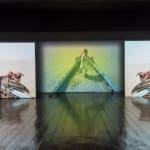
Ranbir Kaleka
Three channel video projection on three panels
3 min 30 seconds loop with sound
84 x 59 inches (213.4 x 149.9 cm) each
Further images
House of Opaque Water is a three-channel video projection that was first showcased at the Kochi-Muziris Biennale in 2012. In this work, Kaleka employs a documentary format to focus on a real-life narrative of Sheikh Lal Mohan, one among many indigenous inhabitants to be displaced as a result of a flood in the low-lying Sundarbans delta. The film outwardly displays how certain communities pay the heavy price of rapid development, in this case, the construction of the Tehri Dam. Kaleka emphasises how rehabilitation may offer the displaced a new place to live but their traditions and cultural identity can only be reclaimed through recall and fantasy. Through a juxtaposition of electronic and familiar, local sounds, he conjures a world of dreams.
Metaphors of fish on the shore, models of submerged homes, and a clock that floats in the water, allude to the dilemmas faced by Lal Mohan and his community. While there is no true reclamation, this conscious exploration of what constituted home for members of the Tehri Village, appears to offer a sense of catharsis. For the viewer, this immersive experience reconstructs the drama of life, loss, and memory.

